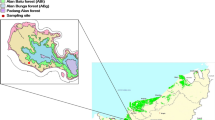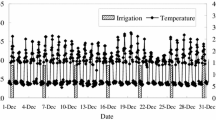Abstract
This study aimed to characterize soil carbon dioxide (CO2) emission associated with soil pore distribution in an Oxisol and Ultisol under chiseling in the planting row and in total area for sugarcane (Saccharum officinarum) cultivation. The experimental design was a large paired-plot design. Treatments consisted of chiseling in the planting row (CPR) and chiseling in total area (CTA) in an Oxisol and Ultisol. Soil CO2 emission, soil temperature, and soil moisture were assessed over 12 days in the Oxisol and 11 days in the Ultisol at a depth of 0–0.10 m. Organic carbon associated with minerals (OCAM) and particulate organic carbon (POC) were also assessed. OCAM, pore class C2 (0.05 ≤ ɸ < 0.1 mm), soil moisture, and soil temperature explained 72 and 53% of the variability of soil CO2 emission in CPR and CTA, respectively. In the Ultisol, pore class C1 (ɸ ≥ 0.1 mm) and OCAM explained 82% of the variability of soil CO2 emission in CPR. In CTA, soil moisture, OCAM, and POC explained 67% of the variability of soil CO2 emission. In the Oxisol, CPR and CTA affected soil structure, causing changes in both soil porosity and soil CO2 emission. In the Oxisol, the lowest average value of soil CO2 emission (2.8 μmol m−2 s−1) was observed in CPR whereas its highest value (3.4 μmol m−2 s−1) was observed in CTA. In the Ultisol, soil tillage (CPR and CTA) did not affect soil CO2 emission. These results indicate that the intensity of soil tillage in more clayey textured soils favors soil CO2 emission possibly due to a higher carbon availability for microbial activity when compared to more sandy textured soils. A less intensive soil tillage can be considered as an efficient strategy to reduce soil CO2 emission and hence soil organic carbon losses. Thus, this management strategy proved to be efficient in terms of mitigating greenhouse gas emissions, reducing the contribution of agriculture to global climate change.






Similar content being viewed by others
References
Bayer C, Mielniczuk J, Martin-Neto L (2000) Efeitos de sistemas de preparo e de cultura na dinâmica da matéria orgânica e na mitigação das emissões de CO2. R Bras Ci Solo 24:599–607. https://doi.org/10.1590/S0100-06832000000300013
BradyNC, WeilRR (2013) Elementos da natureza e propriedades dos solos. Porto Alegre
Braga FVA, Reichert JM, Mentges MI, Vogelmann ES, Padrón RAR (2015) Propriedades mecânicas e permeabilidade ao ar em topossequência Argissolo-Gleissolo: Variação no perfil e efeito de compressão. R Bras Ci Solo 39:1025–1035. https://doi.org/10.1590/01000683rbcs20140724
Cambardella CA, Elliott ET (1992) Particulate soil organic-matter changes across a grassland cultivation sequence. Soil Sci Soc Am J 56:777–783. https://doi.org/10.2136/sssaj1992.03615995005600030017x
Cerri CC, Cerri CEP (2007) Agricultura e aquecimento global Boletim Informativo de Sociedade Brasileira da Ciência do Solo 32:40–44
Christensen BT (1996) Carbon in primary and secondary organomineral complexes. In: Carter MR, Stewart BA (eds) Structure and organic matter storage in agricultural soils. Boca Raton, CRC Lewis, pp 97–165
Claessen MEC (1997) Manual de métodos de análise de solo. Centro Nacional de Pesquisa de Solos, Rio de Janeiro
Costa FS, Bayer C, Zanatta JA, Mielniczuk J (2008) Estoque de carbono orgânico no solo e emissões de dióxido de carbono influenciadas por sistemas de manejo no sul do Brasil. Rev Bras Ci Solo 32:323–332. https://doi.org/10.1590/S0100-06832008000100030
Da Silva MAS, Mafra AL, Albuquerque JA, Bayer C, Mielniczuk J (2004) Atributos físicos do solo relacionados ao armazenamento de água em um Argissolo Vermelho sob diferentessistemas de preparo. C Rural 35:544–552. https://doi.org/10.1590/S0103-84782005000300009
Fao – Food and Agriculture Organization of the United Nations. Statistics Division. (2014) Disponível em: <http://faostat3.fao.org/download/Q/QC/E>. Acesso em: 10 nov 2017
Gabriel KA (1978) Simple method of multiple comparisons of means. J Am Stat Assoc 73(364):724–729. https://doi.org/10.2307/2286265
Iamaguti JL, Moitinho MR, Teixeira DDB, Bicalho ES, Panosso AR, La Scala N (2015) Preparo do solo e emissão de CO2, temperatura e umidade do solo em área canavieira. Rev Bras Eng Agr Amb 19:497–504. https://doi.org/10.1590/1807-1929/agriambi.v19n5p497-504
IPCC – Intergovernmental Panel on Climate Change (2014) Climate Change2014: Synthesis Report. Contribution of Working Groups I, II and III to the Fifth Assessment Report of the Intergovernmental Panel on Climate Change [Core Writing Team, Pachauri RK, Meyer LA (eds.)]. IPCC, Geneva, pp 151
IPT -Instituto de Pesquisas Tecnológicas do Estado de São Paulo (1981) Mapa geomorfológico do Estado de São Paulo São Paulo, pp 94
Jackson ML (1985) Soil chemical analysis.2ed. Prentice Hall, Upper Saddle River
La Scala N, Bolonhezi D, Pereira GT (2006) Short-term soil CO2 emission after conventional and reduced tillage of a no-till sugarcane area in southern Brazil. Soil Till Res 91:244–248. https://doi.org/10.1016/j.still.2005.11.012
Lal R (2009) Challenges and opportunities in soil organic matter research. Eur J Soil Sci 60:158–169. https://doi.org/10.1111/j.1365-2389.2008.01114.x
Li X, Inubushi K, Sakamoto K (2002) Nitrous oxide concentrations in Andisol profile and emissions to the atmosphere as influenced by the application of nitrogen fertilizers and manure. Biol Fertil Soils 35:108–113. https://doi.org/10.1007/s00374-002-0447-7
Lier QJV (2001) Oxigenação do sistema radicular: uma abordagem física. Rev Bras Ci Solo 25:233–238. https://doi.org/10.1590/S0100-06832001000100025
Luo L, Lin H, Li S (2010) Quantification of 3-D soil macropore networks in different soil types and land uses using computed tomography. J Hydrol 393:53–64. https://doi.org/10.1016/j.jhydrol.2010.03.031
Mangalassery S, Sjogersten S, Sparkes DL, Sturrock CJ, Mooney SJ (2013) The effect of soil aggregate size on pore structure and its consequence on emission of greenhouse gases. Soil Till Res 132:39–46. https://doi.org/10.1016/j.still.2013.05.003
Mazurana M, Levien R, Müller J, Conte O (2011) Sistemas de preparo de solo: alterações na estrutura do solo e rendimento das culturas. R Bras Ci Solo 35:1197–1206. https://doi.org/10.1590/S0100-06832011000400013
Mehra OP, Jackson ML (1960) Iron oxide removed from soils and clays by dithionite-citrate system buffered with sodium bicarbonate. Clay Clay Miner 7:317–327
Mooney SJ, Morris C (2008) A morphological approach to understanding preferential flow using image analysis with dye tracers and X-ray computed tomography. Catena 73:204–211. https://doi.org/10.1016/j.catena.2007.09.003
Panosso AR, Marques J Jr, Milori DMBP, Ferraudo AS, Barbieri DM, Pereira GT, La Scala N (2011) Soil CO2 emission and its relation to soil properties in sugarcane areas under slash-and-burn and green harvest. Soil Till Res 111:190–196. https://doi.org/10.1016/j.still.2010.10.002
Perecin D, Ferraudo GM, Azania CAM, Schiavetto AR (2015) Statistical analysis for correlated paired-plot designs. Am J Exp Agric 9:1–7. https://doi.org/10.9734/AJEA/2015/20722
R Development Core Team (2011) R: a language and environment for statistical computing. R Foundation for Statistical Computing, Vienna, Austria. ISBN 3-900051-07-0, URL: http://www.R-project.org/
Roscoe R, Buurman P (2003) Tillage effects on soil organic matter in density fractions of a Cerrado Oxisol. Soil Till Res 70:107–119. https://doi.org/10.1016/S0167-1987(02)00160-5
Santos HG, Jacomine PKT, Anjos LHC, Oliveira VA, Oliveira JB, Coelho MR, Lumbreras JF, Cunha TJF (2013) Sistema brasileiro de classificação de solos, 3rd edn. Embrapa Solos, Rio de Janeiro 353 p
SAS Institute (1987) SAS – Statistical Analysis System: system for elementary statistical analysis. SAS Institute, Cary, p 416
Schwartz RC, Baumhardt RL, Evett SR (2010) Tillage effects on soil water redistribution and bare soil evaporation throughout a season. Soil Till Res 110:221–229. https://doi.org/10.1016/j.still.2010.07.015
Shestak CJ, Busse MD (2005) Compaction alters physical but not biological indices of soil health. Soil Sci Soc Am J 69:236–246. https://doi.org/10.2136/sssaj2005.0236
Souza FCAde (2016) Atributos físicos de solos submetidos à escarificação na linha de plantio e em área total para cultivo da cana-de-açúcar. Dissertação, Faculdade de Ciências Agrárias e Veterinárias
Souza ZM, Alves MC (2003) Propriedades físicas e teor de matéria orgânica em um Latossolo Vermelho de cerrado sob diferentesusos e manejos. Acta Sci Agron 25:27–34
Souza GS, Souza ZM, Silva RB, Barbosa RS, Araújo FS (2014) Effects of traffic control on the soil physical quality and the cultivation of sugarcane. Rev Bras Ciênc Solo 38:135–146
Souza LC, Fernandes C, Nogueira DCS, Moitinho MR, Bicalho ES, La Scala N (2017) Can partial cultivation of only the sugarcane row reduce CO2 emissions in an Oxisol and Ultisol? Agron J 109(3):1113–1121
Teixeira LG, La Scala N, Lopes A (2010) Fluxo de CO2 do solo após aração e escarificação em diferentes configurações. Holos Environ 10(1):1–11
Ussiri AN, Lal R (2009) Long-term tillage effects on soil carbon storage and carbon dioxide emissions in continuous corn cropping system from an alfisol in Ohio. Soil Till Res 104:39–47. https://doi.org/10.1016/j.still.2008.11.008
Zhou X, Lin HS, White EA (2008) Surface soil hydraulic properties in four soil series under different land uses and their temporal changes. Catena 73:180–188. https://doi.org/10.1016/j.catena.2007.09.009
Funding
To the Graduate Program in Agronomy (Soil Science) of the São Paulo State University (FCAV–UNESP) and to the Coordination for the Improvement of Higher Education Personnel (CAPES) and the São Paulo Research Foundation (FAPESP) for the financial support (process no. 2014/14490–2).
Author information
Authors and Affiliations
Corresponding author
Rights and permissions
About this article
Cite this article
de Souza, L.C., Fernandes, C., Moitinho, M.R. et al. Soil carbon dioxide emission associated with soil porosity after sugarcane field reform. Mitig Adapt Strateg Glob Change 24, 113–127 (2019). https://doi.org/10.1007/s11027-018-9800-5
Received:
Accepted:
Published:
Issue Date:
DOI: https://doi.org/10.1007/s11027-018-9800-5




